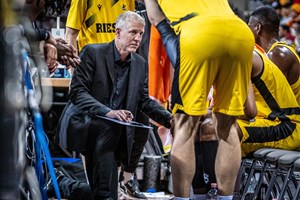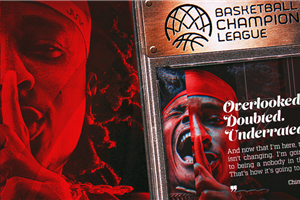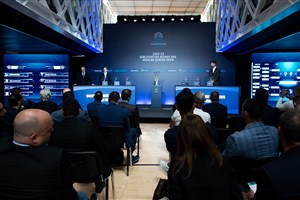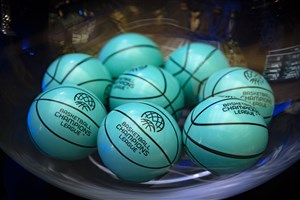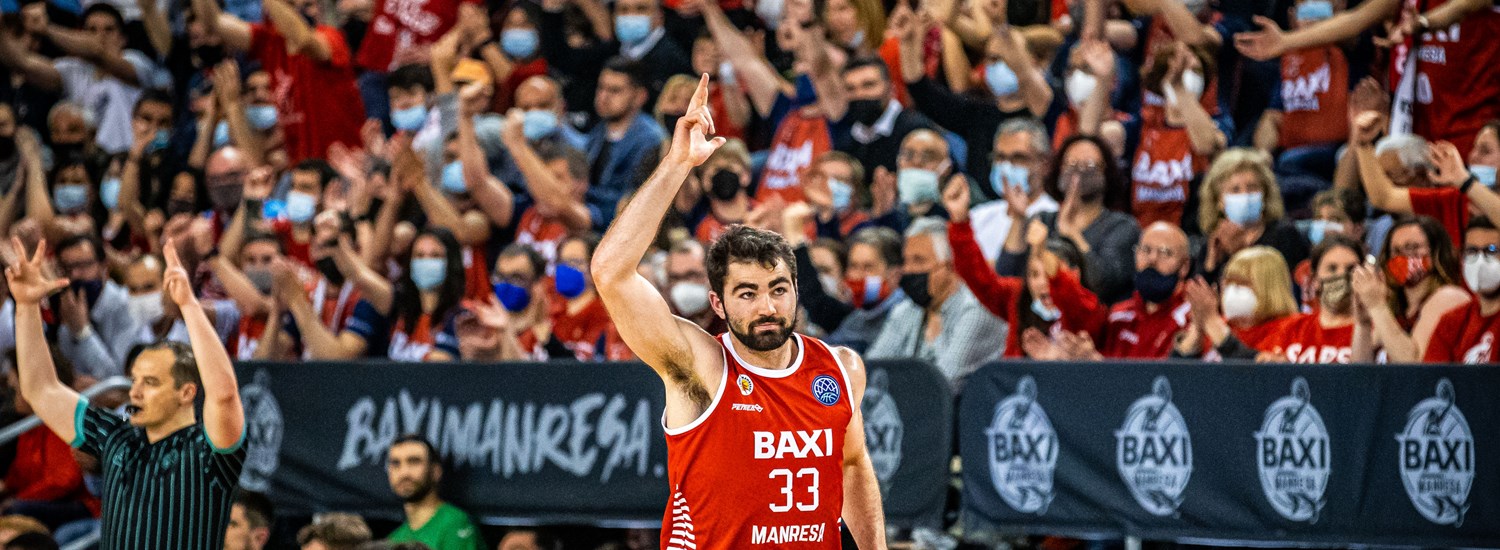
Red Hot - a closer look at BAXI Manresa
MIES (Switzerland) – BAXI Manresa might be the hottest team in Europe. They have already beaten both Real Madrid and Barcelona on the road in the Liga Endesa and have occupied a top-four position in the standings for long stretches of the season. Qualifying for the Final Four of the Basketball Champions League (BCL) almost certainly also qualifies as their best season ever in Europe. Whilst the history of winning the Liga Endesa (ACB) in 1998 still stands out as the club's greatest ever season, if we consider that the club was playing in the LEB Gold as recently as 2018, it's hard to argue against the notion that winning the BCL in Bilbao this May, would be enough for this group to claim the mantle of enjoying BAXI Manresa's greatest ever season.
How They Play
The starting five has changed regularly during the season but the two mainstays in every lineup are Dani Perez and Joe Thomasson. This team wants to play uptempo all the time and their two starting guards certainly set the pace. The most consistent players in the other starting roles have been Juampi Vaulet, Chima Moneke, and Ismael Bako but we did see Yankuba Sima start when Bako was hurt, and both Luke Maye and Rafa Martinez have also started in recent games.
The idea behind every lineup Pedro Martinez puts on the floor is to get the ball up the floor fast and get into their offense as quickly as possible. Then the aim is to maintain the best spacing and movement possible, with cutters and shooters relentlessly putting themselves in scoring positions. What we will surely see in high volumes at the Final Four, is Martinez's "Drag Offense". A Drag screen is terminology for a ball screen set in transition or early offense. For Manresa, it's not just about the actual screen itself but the way they use it to enter and flow into the other actions.
Drag Offense
The first thing to notice in the clip below is where #55, Dani Perez, is on the floor when he catches the outlet. Manresa want to push tempo from a make or a miss and their guards are great at being available as early and as high up the court as possible. What happens next is the Drag screen. Perez fakes the spin to set up the screen and when Unicaja go under, it's an instant re-screen back to the baseline. In this case, no advantage is created so the ball reverses into their "Drag Offense". #11, Chima Moneke uses the dribble to reverse the ball, triggering a "45 Cut" from the next player on the weak side, if that pass to the cutter isn't open, then they are in a handoff (DHO) or ball screen action on the other side of the floor. in this clip, the first reversal doesn't yield an advantage, so the ball reverses again and Perez creates an advantage from another ball screen - again using a crafty dribble to his left to set up his defender for the screen. Watch the cut from the corner by Moneke as soon as he realizes that #77, Sima is going to catch the ball on the roll.
We see the same offense again in the next clip, only this time Perez uses a "Deep Drag", forcing the ball lower than the free-throw line before using the screen. We also see the same flow of actions but on this occasion, slightly more disruptive defense. Pay attention to the way that Perez and Bako read the final screen. Perez sees his defender go under so turns back to the middle of the floor and Bako screens his own defender to prevent any help (this is known as a "Gortat" screen). Again, we see the same cut from Moneke to receive the pass. All five players are moving or consciously holding the spacing at all times and the ball flows from one action to the next like an Olympic relay. If Manresa are able to play this fluently, they are very difficult to stop.
It's not always the same movements or the same starting position of the screen. A slight change of the starting screen from a deep position to "The Slot" - as we see in the video below - and a change in defensive coverage can result in very different movements in the offense. Watch how they replace the 45 Cut on the weakside with the same player drifting to the corner and the player in the corner either cutting or setting a pin screen. The reason for this change is almost certainly because Unicaja are helping aggressively on the free-throw line (otherwise known as "Nail Help" or "Next" defense). In both clips, it's Unicaja's #8, Dario Brizuela helping on the nail. Watch #33, Luke Maye screens his own defender in the first clip to prevent a defensive rotation out to #32, Joe Thomasson.
Finally, in the video below we see a completely different angle on the first ball screen. This time what we see is called an "Angle" screen with the screener's back to the strong side corner (this can also be a "Step-Up" screen with the screener's back parallel to the baseline). Again, you see different coverages and again, you see different ways to punish them each time. In the first clip, in particular, we see what makes Chima Moneke such a tough customer to defend. If he's able to face up and drive the ball, he's going at the defense with all the speed and agility you'd expect to see from a wing or even a guard.
Manresa shoot more threes than any other team at the Final Four and the largest share of those come from their drag offense. The video below is two more clips of that angle or step-up screen in transition, only this time Unicaja defend the action and force them to reject the screen to the middle of the floor. The outcome is still the same; great spacing, rapid player movement, rapid ball movement, then bang, open three.
Half-court Sets
Both clips below are after dead ball situations so Manresa are into their half-court offense. The flow and spacing principles are exactly the same. You will, by now, probably recognize the cut by Moneke in the first clip but it was created by the defense sending two defenders to the ball and hedging the screen, which opened up the pass to the short-roll. In the second clip we see the defense attempt to cover the ball screen 2v2 but against scorers like Joe Thomasson and Sylvain Francisco, this is a risky business.
It's the same set play in the clip below but they are forced to run four different ball screens before finally creating an advantage - which is exactly why it's the perfect clip to really highlight the flow and tempo this Manresa team plays with.
Finally, the last set that we will absolutely see Manresa running at the Final Four is this "Diamond" in the clip below. The play starts with screeners on the elbows, and wings opposite each other on the free-throw line and under the rim. After that, it's side ball screen into middle ball screen and more of the same offensive flow (and another great example of Moneke attacking the rack). Moneke comes into Bilbao fresh from winning the MVP of the month award and plays like this were a huge part of him winning that award.
Oh, and if you do see Pedro Martinez call a timeout with less than 30 seconds on the clock, make sure you watch out for the Ghosts.
Defense
On the defensive end, it's all about disruption for Manresa. Their opponents in the Final Four, Ludwigsburg, are known for their relentless pressure defense. Pedro Martinez's squad also loves to leverage the speed of their roster to press and harass teams full court. They want to be in the passing lanes as often as possible and never allow anything easy.
Despite being possibly a bit undersized in the frontcourt, Manresa make up for it by being the best team in the Final Four when it comes to defending the roller in ball screen actions. Per Synergy, they give up just 0.67 points per play when teams try to hit the roller. They also force turnovers on over 17 percent of those possessions.
They are also elite when it comes to defending in transition and against isolation plays. Per Synergy, they give up just 0.98 points per play in transition. Only Ludwigsburg have been better this season. Much like their German opponents in the Final Four, they want to run at you and also prevent you from running at them. It sounds simple and, of course, that's what every team wants to do. The problem is that not every team is able to do that. Manresa are one of the teams that are.
Data Story
Manresa lead the league in Assists at 21.8 per game and are second amongst teams at the Final 4 with an Assist Percentage of 74.2 percent, which essentially means they record an assist for 74.2 percent of their made Field Goals. The way they share the ball also powers one of the BCL’s most efficient offenses. They have an Offensive Rating of 112.4 points scored per 100 possessions, good for second amongst Final Four teams.
On the defensive end, Manresa record the second-most steals per game in the BCL at 8.1 and they also rank second in the league for Defensive Rating, conceding just 101 points per 100 possessions. Putting the whole picture together on offense and defense, Manresa have the top Net Efficiency Rating of any team in the league at +11.3 points per 100 possessions.
The chart above shows you the data story of their season so far. You have four tabs to explore; Efficiency Ratings, Shooting, Possession, and Pace. You can see that each column corresponds to a Gameday from the season and colored lines represent the relative stat they recorded for that game. You can also filter by home or road games and wins or losses. Whilst the axes and labels are left blank to avoid cluttering the visual, you can hover over each point on the chart to see the labels.
You can adjust the filters and switch tabs to analyze the data for yourselves but we picked out some filter settings that might give us some insights in the charts below. In the Efficiency Ratings tab, we have filtered for road games only and what we can see is that Manresa's Defensive Rating has been trending up on the road (that's bad). They actually had their worst game of the season defensively in the second leg of the Quarter-Final against Unicaja, allowing 127 points per 100 possessions. They did, of course, find a way to win that game (and the series), largely thanks to also having their best offensive game, scoring 129.8 points per 100 possessions.
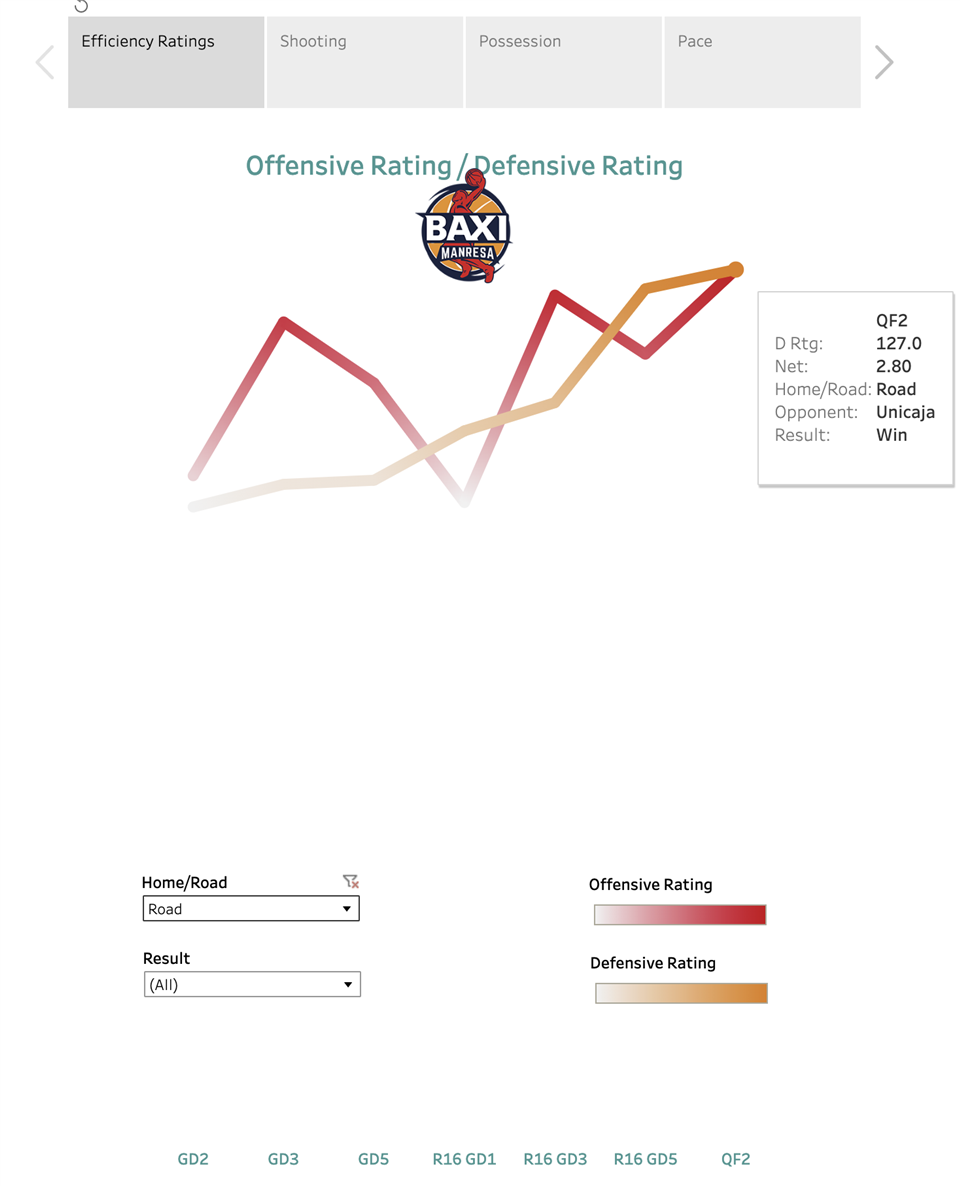
Another trend to keep an eye out for could be the way this team has been steadily improving the way they shoot the ball on the road. Effective Field Goal Percentage (eFG%) takes three-point shooting into account and measures shots more in relation to the points gained per shot. The fact that Manresa's eFG% has been steadily increasing on the road all season means that they have not only been making more shots on the road but also likely means that they have been taking better shots as the season has gone on. This is an encouraging sign as they travel to Bilbao and one - potentially two - of their biggest road games of the season.
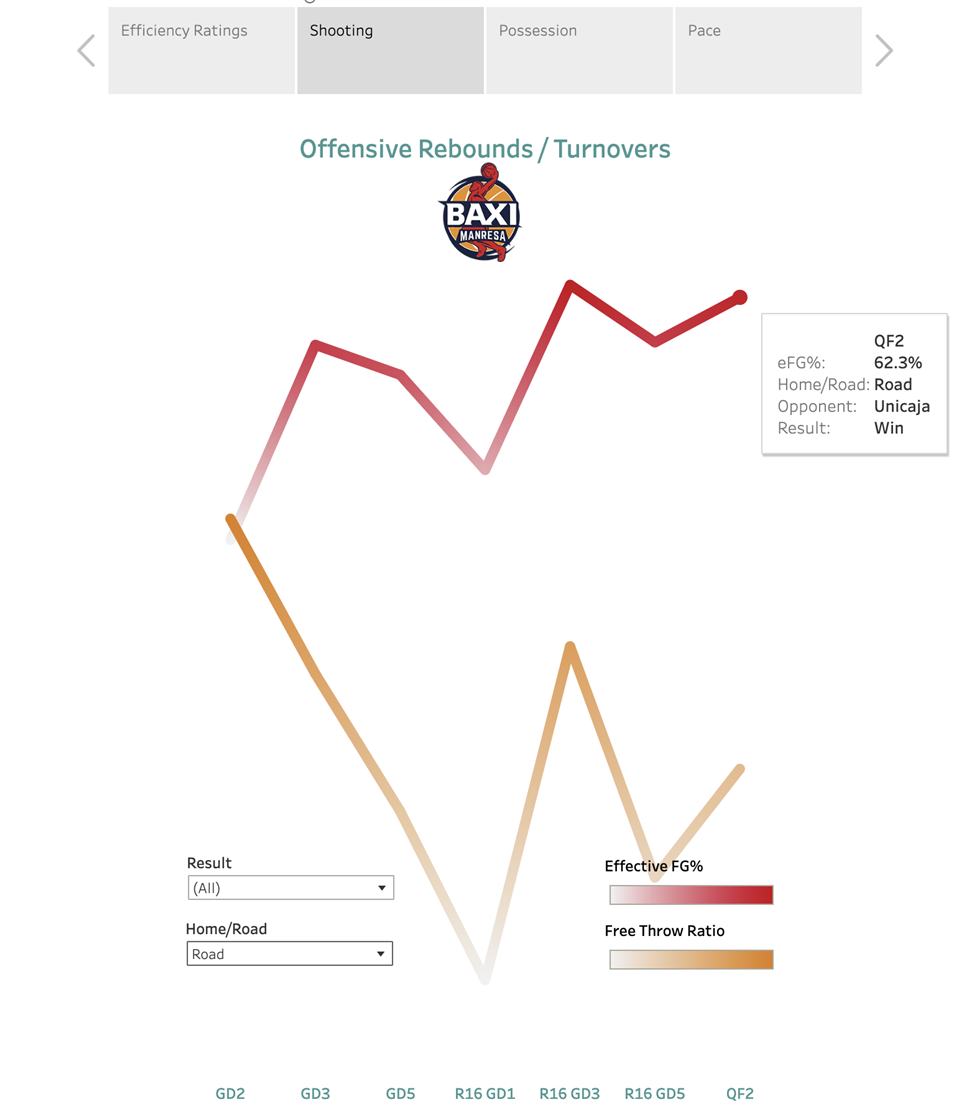
Now, the caveat to both the charts above - and also any analysis that you may decipher yourself from the charts - is that the number of games means that we are working with a relatively small sample size but that is always the case in the BCL and that doesn't mean that performance trends in the most recent games aren't likely to impact the way we see teams play in Bilbao.
Season Story
BAXI Manresa went into the season drawn in what looked like a group of death with pre-season favorites Pinar Karsiyaks and Hapoel Bank Yahav Jerusalem. Their response was to go five games unbeaten to start the season and in the process picked up wins on the road against both Jerusalem and Karsiyaka. Sylvain Francisco really introduced himself to the competition with 23 points in the win at Jerusalem. Then in the following home win against Pinar Karsiyaka, Joe Thomasson and Ismael Bako combined for 41 points with Bako shooting 100 percent from the field. By this point, the entire league was starting to realize that this Manresa team was a real threat. In the next game on the road at Arged BM Stal Ostrow Wielkopolski, Chima Moneke lead the team with 16 points as they picked up a 75-88 win. They weren’t defeated until the very last game of the Regular Season when Jerusalem prevented them from completing the double over every team in the group.
The Round of 16 didn’t start as auspiciously when they lost on the road to Tofas Bursa. Luke Maye’s 31 points was the only bright spot for Manresa in that game. They got back to winning ways in the next home game against Darussafaka. Juampi Vaulet made his mark on the season with 13 points after replacing injured captain Guillem Jou during the Regular Season. They then scored more than 100 points twice in a row as they recorded back-to-back wins over Nutribullet Treviso. Joe Thomasson scored 16 points in each game. After that, Manresa went 1-1 against Darussafaka and Tofas, meaning they split their games with both Turkish clubs. Yankuba Sima’s double-double with 14 points and 16 rebounds against Tofas was a real standout performance of the Round of 16.
🔴 𝙁𝙄𝙉𝘼𝙇 𝙁𝙊𝙐𝙍 𝘽𝙊𝙐𝙉𝘿 🔴#BasketballCL #FinalFour I @BasquetManresa pic.twitter.com/GftuevWJcq
— Basketball Champions League (@BasketballCL) April 12, 2022
The Quarter-Finals paired Manresa with Unicaja in an all-Spanish derby. In the first half of game one Manresa expelled any doubts over their credentials and produced one of the best Play-Offs performances ever seen in the BCL. They won the first quarter 29-4 and prevented Unicaja from recording a single made field goal - the first time a team hasn’t made a field goal in an entire quarter since the league began. Joe Thomasson’s 16 points and 5 rebounds, partnered with Chima Moneke’s 11 point and 11 rebound double-double guided Pedro Martinez’s squad to a commanding 86-63 win. With work still to be done and a Liga Endesa rival looking to win back some pride, Manresa traveled to Malaga and fired on all cylinders on the offensive end, shooting 52.5 percent overall and 40 percent from behind the arc as they powered past Unicaja 89-91. Joe Thomasson’s game-winner off the dribble with just a second on the clock secured the series and also provided one of the highlights of the season.
🥶🧊 𝙄𝙎𝙊 𝙅𝙊𝙀 SENDS BAXI MANRESA TO THE #BASKETBALLCL #FINALFOUR! 🥶🧊 @BasquetManresa I @JT_thomassonJr pic.twitter.com/FEUyHVLmcI
— Basketball Champions League (@BasketballCL) April 12, 2022
Up Next
MHP Riesen Ludwigsburg, Friday May 6, 21:00 (GMT+2). This is the battle of the two most rapid and aggressive teams in the BCL this season. Blink and you'll miss it, so don't blink because you really don't want to miss it.






